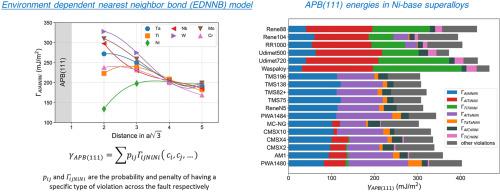Intermetallics ( IF 4.3 ) Pub Date : 2021-02-12 , DOI: 10.1016/j.intermet.2021.107124 K.V. Vamsi , S. Karthikeyan

|
An environment dependent nearest neighbor bond (EDNNB) model was developed to estimate the antiphase boundary (APB) energies in γ′ precipitates (L12 structure) in commercial Ni-base superalloys. In this approach, the most frequent combination of nearest neighbor violations across an APB on the {111} planes in the Al-sublattice were identified. Further, the effect of alloying elements such as Ta, Ti, Nb, W, Mo, Ni, and Cr on seven unique combinations of violations on the APB(111) energies (, X, Y Al, Ta, Ti, and Cr in the Al-sublattices) was systematically studied. First-principles calculations were employed to evaluate by substituting Al atoms in the supercells by alloying elements on planes adjacent to the APB(111). The effect of alloying and interaction with a unique violation on APB(111) is captured through an environment strength coefficient, η. Interestingly, Ta and Nb have similar effects on the APB energies. Similarly, the effects are equivalent when the substitution is W or Mo irrespective of the combination of violation on the APB(111). The alloying effect is dramatic when the substitutions are within the vicinity of the APB(111). Ni substitution leads to a reduction of APB energy when the violations are of type Al–Al across the APB(111). All alloying additions increase the APB energy when the violation is Ti–Ti across the APB. Additionally, the magnitude of the strength coefficients is significantly higher than the other type of violations considered in this study. The strength coefficients are negative when the APB(111) has Ti–Cr violations, suggesting a driving force for segregation to APB(111). In conclusion, the creation of more Ti–Ti and Al–Ti violations is beneficial to increase the strength of the precipitate. APB energies in many disk and blade alloys were predicted using strength coefficients. The trends in APB energies are in good agreement with the trends in yield strength within the subsets of blade and disk alloys. The development of the EDNNB model opens avenues for predicting planar fault energies in novel multi-principal element compositions strengthened by L12 were discussed.
Al, Ta, Ti, and Cr in the Al-sublattices) was systematically studied. First-principles calculations were employed to evaluate by substituting Al atoms in the supercells by alloying elements on planes adjacent to the APB(111). The effect of alloying and interaction with a unique violation on APB(111) is captured through an environment strength coefficient, η. Interestingly, Ta and Nb have similar effects on the APB energies. Similarly, the effects are equivalent when the substitution is W or Mo irrespective of the combination of violation on the APB(111). The alloying effect is dramatic when the substitutions are within the vicinity of the APB(111). Ni substitution leads to a reduction of APB energy when the violations are of type Al–Al across the APB(111). All alloying additions increase the APB energy when the violation is Ti–Ti across the APB. Additionally, the magnitude of the strength coefficients is significantly higher than the other type of violations considered in this study. The strength coefficients are negative when the APB(111) has Ti–Cr violations, suggesting a driving force for segregation to APB(111). In conclusion, the creation of more Ti–Ti and Al–Ti violations is beneficial to increase the strength of the precipitate. APB energies in many disk and blade alloys were predicted using strength coefficients. The trends in APB energies are in good agreement with the trends in yield strength within the subsets of blade and disk alloys. The development of the EDNNB model opens avenues for predicting planar fault energies in novel multi-principal element compositions strengthened by L12 were discussed.
中文翻译:

多组分镍基高温合金中APB能量的建模
建立了与环境有关的最近邻键(EDNNB)模型,以估计商用镍基高温合金的γ'析出物(L1 2结构)中的反相边界(APB)能量。在这种方法中,确定了Al子晶格中{111}平面上APB上最近邻居违规的最频繁组合。此外,合金元素(例如Ta,Ti,Nb,W,Mo,Ni和Cr)对APB(111)能量违反的七个独特组合的影响(, 系统地研究了Al亚晶格中的X,Y Al,Ta,Ti和Cr。第一性原理计算用于评估通过在与APB(111)相邻的平面上合金化元素来取代超级电池中的Al原子。通过环境强度系数η记录了APB(111)的合金化和相互作用以及独特破坏的影响。有趣的是,Ta和Nb对APB能量有相似的影响。同样,当替换为W或Mo时,无论APB(111)上违反的组合如何,效果都是相同的。当取代基在APB(111)附近时,合金化效果非常显着。如果在整个APB上违反Al-Al类型,则Ni替代会导致APB能量的降低(111)。当在整个APB上违反Ti-Ti时,所有合金添加都会增加APB能量。此外,强度系数的大小明显高于本研究中考虑的其他类型的违规行为。当APB(111)违反Ti–Cr规范时,强度系数为负,这表明向APB(111)偏析的驱动力。综上所述,产生更多的违反Ti-Ti和Al-Ti的行为有利于增加沉淀物的强度。使用强度系数可以预测许多磁盘和刀片合金中的APB能量。APB能量的趋势与叶片和圆盘合金子集中的屈服强度趋势完全一致。EDNNB模型的开发为预测由L1增强的新型多主要元素组成中的平面断层能量开辟了途径讨论了2个。
系统地研究了Al亚晶格中的X,Y Al,Ta,Ti和Cr。第一性原理计算用于评估通过在与APB(111)相邻的平面上合金化元素来取代超级电池中的Al原子。通过环境强度系数η记录了APB(111)的合金化和相互作用以及独特破坏的影响。有趣的是,Ta和Nb对APB能量有相似的影响。同样,当替换为W或Mo时,无论APB(111)上违反的组合如何,效果都是相同的。当取代基在APB(111)附近时,合金化效果非常显着。如果在整个APB上违反Al-Al类型,则Ni替代会导致APB能量的降低(111)。当在整个APB上违反Ti-Ti时,所有合金添加都会增加APB能量。此外,强度系数的大小明显高于本研究中考虑的其他类型的违规行为。当APB(111)违反Ti–Cr规范时,强度系数为负,这表明向APB(111)偏析的驱动力。综上所述,产生更多的违反Ti-Ti和Al-Ti的行为有利于增加沉淀物的强度。使用强度系数可以预测许多磁盘和刀片合金中的APB能量。APB能量的趋势与叶片和圆盘合金子集中的屈服强度趋势完全一致。EDNNB模型的开发为预测由L1增强的新型多主要元素组成中的平面断层能量开辟了途径讨论了2个。











































 京公网安备 11010802027423号
京公网安备 11010802027423号